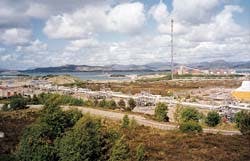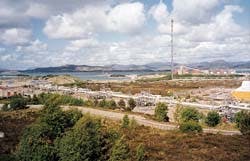Norway seeks to leverage upstream to expand its downstream industry
L.R. Aalund
Managing Editor-Technology
The Fensfjord, shown in the distance alongside the Mongstad refinery and terminal, is a tanker captain's dream, with its ultradeep waters. Shipments of LPG from the Mongstad terminal will increase when the Vestprosess operation begins in October 1999.
- This whimsical troll stands alongside the Troll field crude pipeline as it enters Statoil's Mongstad refinery. The encasement around the pipe in the foreground contains a corrosion monitoring instrument. A second line will link the refinery to more Troll oil next year. Photo courtesy of Norwegian Trade Council. [11,376 bytes]
- The fluid catalytic cracker at Mongstad is shown in late May of this year in the final stages of a major upgrade. The UOP/Ashland Reduced Crude Conversion (RCC) unit now runs comfortably at a feed rate of 350 metric tons/hr-the revamped design capacity-compared with an original design rate of 250 tons/hr. The unit is now capable of running heavier feeds that will come with increased Troll crude throughput. Mongstad is mainly an export refinery, with only 33% of output consumed in Norway. [12,504 bytes]
- Vestprosess Program Overview [126,485 bytes]
- Vestprosess Flow Diagram [107,204 bytes]
- Norway's Fields [131,143 bytes]
The move to integrate downstream processing with upstream development is designed to eliminate the need to export raw materials.
Stein Arne Frøseth, an adviser in refining business development and technology for Statoil, recently outlined the firm's downstream situation and strategy for Oil & Gas Journal. There are three major elements in Statoil's plan:
- Start-up of a joint-venture incorporated company, Vestprosess DA, to bring a large volume of North Sea condensate and NGL to Mongstad, Norway, site of Statoil's big refinery.
- Integration of the Mongstad refinery with a new gas-liquids fractionator, to be built by Vestprosess.
- Emphasis on refining "marginal" Norwegian crudes (crudes from smaller fields or crudes that present special processing problems, such as high acidity or salt content). Such crudes can be a bargain for the refiner that can handle them.
"We are in control of our raw materials. Other refiners must fight to get hold of raw materials. That is an advantage we have as a refining company."
Vestprosess
Vestprosess is a group of six companies, led by Statoil. Interests in the venture are: Statoil 58%, Saga Petroleum AS 17%, Mobil Development Co. Norway 10%, Norske Shell AS 8%, Total Norge AS 5% and Norske Conoco AS 2%.To understand the incentive for the formation of the Vestprossess group and the potential for a major expansion in Norwegian refining and petrochemical activity, it is necessary to unravel a complex but synergistic relationship among several Norwegian oil and gas fields, pipelines, terminals, and the 154,000 b/d Mongstad refinery.
The fields are Oseberg, Troll, and some smaller producers in the North Sea. They are northwest of Bergen, Norway's second largest city. The terminals are on rocky islands in the archipelago near Bergen.
Condensate and NGL from these fields will be piped to Mongstad, where there also is a major crude oil terminal. These liquids are the key to Vestprosess's development plans.
Terminals at Sture and Kollsnes will also be targets for the NGL and condensate.
Following are a review of Norway's existing production and transportation systems and details on the changes planned.
Troll crude, gas
Troll field produces natural gas, NGL, condensate, and crude oil.Troll crude currently makes up about 25% of the input to the Mongstad refinery. This crude is transported through the Troll Oil Pipeline, a 16-in., 86-km line that crosses the Norwegian trench at a depth of 500 m. Such water depths, and the basement rock and mountainous heights that make up much of the Norwegian coast, make it economically impossible for the country to utilize much of its large natural gas resource domestically.
Further oil production development is going on in Troll field. A second crude oil pipeline is being laid from the Troll area to Mongstad. This 20-in., 80-km line, designated Troll Oil Pipeline II, is expected to be ready for operation next year.
This line, and another new condensate/NGL line (the Vestprosess line) from Kollsnes to Mongstad, are necessary to handle the increased production that will result from the commissioning of Troll C floating production platform next year.
Increased oil production means more gas and condensate from Troll C. This, the Ministry of Petroleum and Energy says, will probably require expansion of the separation plant at Kollsnes, which is already receiving condensate and gas from Troll.
The separated condensate is sent via pipeline to the Sture terminal, where it is exported by ship. The dry Troll gas goes from Kollsnes to Zeebrugge, Belgium, through the Zeepipe system, and to Emden, Germany, via Statpipe/Norpipe systems.
Vestprosess also will build an NGL fractionation plant at Mongstad. It is slated for completion in October 1999 as well.
Oseberg
Oseberg field is the second important element in the Vestprosses development.Another major change slated for next year is that NGL from Oseberg field will join the condensate going to Mongstad in the Vestprosses line, now being laid (see diagram at upper left). A "Y" connection in the new line will provide access for the Oseberg NGL.
Plans are for the 12-in. Vestprosess line, traversing rugged terrain, to be completed in October 1999. It will carry 20,000 b/d of condensate and NGL.
Stable crude oil containing no NGL is now being transported in a 28-in., 115-km pipeline from Oseberg field to the Sture terminal. This crude will become unstable when natural gas production from Oseberg starts in October 1999.
The crude will then be mixed with NGL offshore, after the NGL is separated from the wet gas. At Sture, the Oseberg LPG will be separated from the crude, mixed with Troll condensate via a "Y" connection, and sent on through the Vestprosess line to Mongstad.
The dry gas from Oseberg, the ministry says, will be transported in a 36-in., 108-km pipeline to Heimdal field. There, it will connect with the Statpipe system and go to Western Europe.
Mongstad
The lower diagram on p. 30 illustrates the final effect of all these changes. The green lines show the Vestprosess functions.About 1.5 million metric tons/year of condensate and LPG will come into the Mongstad refinery as a result of this new company's activities. The refinery, although a separate entity, will be fully integrated on the operations side with Vestprosess and is expected to benefit from the arrangement.
The refinery will process the Vestprosess condensate into finished naphtha, gas oil, kerosine, and diesel. The refinery will also sell a large amount of engineering services to Vestprosess. And it will have an outlet for the LPG it now makes and has difficulty utilizing.
Although the Vestprosess participants can export their share of the liquids, all this LPG at one location raises the prospect of an olefins-based petrochemical complex at Mongstad.
Frøseth said, "Statoil has been looking at steam crackers in previous years and is still looking at them. We have plenty of space here."
And, he added, without going into detail, "We have started working with Vestprosess II even before Vestprosess I is constructed. We clearly see expansions."
He also believes Vestprosess will bring many more companies to Mongstad.
Raytheon Engineers & Constructors is upgrading the Mongstad refinery crude unit to process the lighter feedstock that will be coming in and is building the NGL fractionation plant and LPG storage caverns. The caverns are in the cool-down phase, during which temperatures will be held well below freezing for 6 months.
These projects and the pipeline together will cost $200 million, Frøseth says.
Refining
Frøseth used Yme-field crude to illustrate Statoil's refining strategy.Yme field occupies a lonely position in the southern Norwegian sector of the North Sea. Yme is small, and the crude is salty. The field has been developed at low cost with a jack up platform linked to a tanker for storage and export. Yme has reserves of only 40 million bbl and produces 30,000 b/d.
Optimum storage capacity cannot be installed on fields of that size, Frøseth says. This gives these crudes high freight costs, because the crude often goes out on half-loaded tankers.
These characteristics prevent such crudes from establishing market reputations and give them a market price far less than their technical value in a refinery that has been adapted to handle them. In other words, they can be bargains.
Mongstad has beefed up its desalters to handle Yme crude.
The era of great crudes such as Statfjord, Gullfaks, and Ekofisk dominating the North Sea may be ending. Frøseth sees numerous small-volume crudes appearing by 2000 and later.
They will pose a variety of refining problems. They will be more acidic, which will create corrosion problems; or they will have high pour points, contain high concentrations of wax, or form strong emulsions.
There also will be an increasing amount of condensate from developments such as Aasgard (see story, p. 66).
Statoil traders already have a problem keeping up with the large number of crudes now available. The tables on this page list fields under development, or under consideration for development, off Norway.
The company also sees an opportunity in Heidrun crude. The high acidity of this crude limits its use mostly to some refineries in the U.S. These plants are equipped to deal with the corrosion problem, and can buy Heidrun crude at low cost.
Production of acidic crudes is on the increase in the North Sea, Frøseth says. And Statoil is developing new technology to cope with them. The process adds hydrogen to the crude to remove the naphthenic acid in a low-temperature reactor.
"If we can remove the acids cheaply, Heidrun crude will have a high technical value," he said.
Norway's plans for further developing its downstream sector will help it add value to its raw hydrocarbons by converting them to refined products and petrochemicals.
By entering the Vestprosess joint venture, Statoil has simultaneously strengthened its downstream position while supporting its upstream developments.
Copyright 1998 Oil & Gas Journal. All Rights Reserved.

